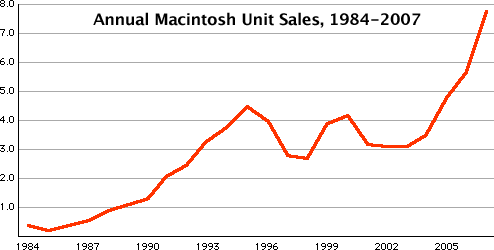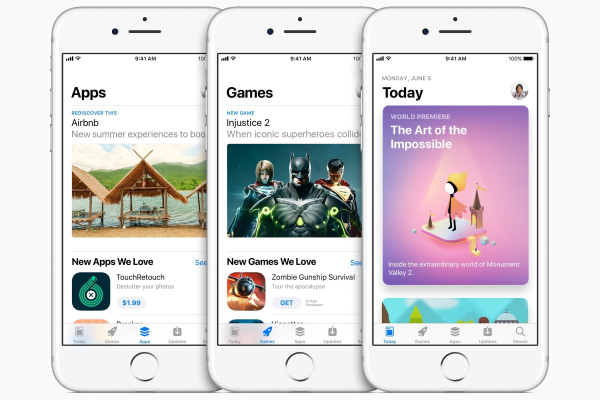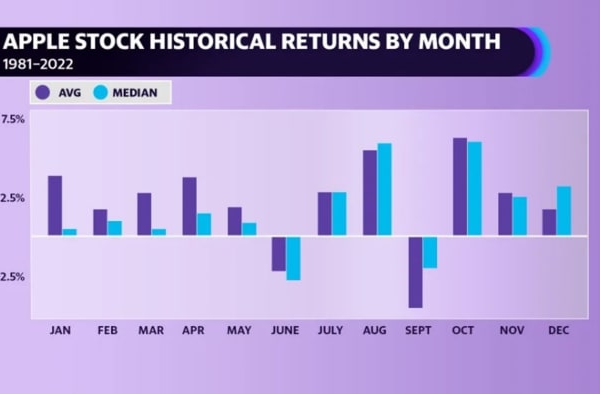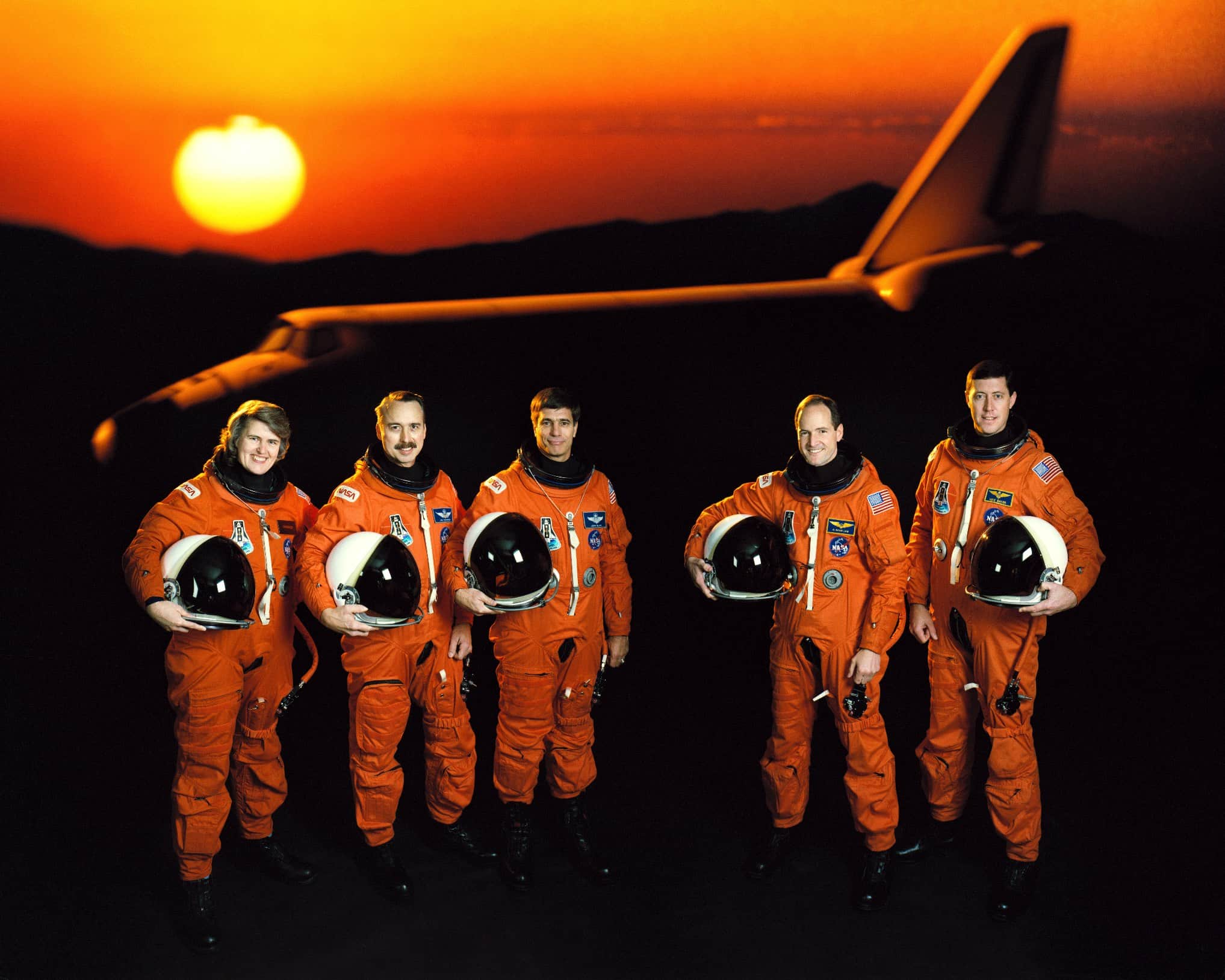Macintosh Sales History: Triumphs and Challenges in 1984

The Macintosh sales history is a fascinating tale of ambition and innovation that dates back to the product’s launch on January 24, 1984. Created against a backdrop of previous failures, such as the Apple III and Lisa, the launch was spearheaded by Steve Jobs, who envisioned a user-friendly computer for the masses. Initial sales during the Mac’s first 100 days exceeded expectations, with 72,000 units sold, a testament to the public’s enthusiasm for this new technology. However, while the history of Macintosh reflects an early success story, challenges soon emerged as interest waned and competition intensified. As we delve deeper into this captivating journey, we will uncover how the Macintosh not only transformed Apple’s fortunes but also reshaped the landscape of personal computing.
The story of Macintosh sales symbolizes the trials and triumphs of a groundbreaking product that sought to redefine the computer market. Following the turbulent period of prior Apple product releases, the Macintosh emerged as a symbol of hope and ingenuity, driven by the vision of its iconic creator, Steve Jobs. Despite a strong start, evidenced by impressive sales figures in its initial days, the journey of the Mac was fraught with obstacles that required strategic pivots and innovative marketing efforts. This narrative encapsulates the essence of the enduring impact that the Macintosh has had, not only on Apple’s legacy but also on the evolution of technology itself. Let’s explore how this ambitious venture transformed from a momentous launch into a complex sales history filled with lessons and insights.
The Historic Launch of the Macintosh
On January 24, 1984, Apple unveiled the Macintosh, a personal computer that would change the course of technology. This launch was a bold move for Apple, especially considering its recent setbacks with the Apple III and Lisa. The Macintosh 128K, though a groundbreaking innovation, faced significant challenges, including fierce competition from established players like IBM, who had already set up a stronghold in the personal computer market. The pricing strategy was also contentious; at $2,500, it was viewed as too expensive for the average consumer, contrasting starkly with the goal of creating an affordable device under Jeff Raskin’s vision.
Nevertheless, the enthusiasm surrounding the Macintosh launch was palpable, fueled by the marketing genius of Steve Jobs. During this period, Apple sought to capture the public’s imagination, and their marketing efforts culminated in the famous Super Bowl ad that introduced the Macintosh to millions. The company’s gamble paid off as they sold an impressive 72,000 units within the first 100 days, exceeding expectations. Jobs’s initial forecast of 50,000 units seemed conservative in hindsight, showcasing the potential for the Macintosh as a revolutionary product within the tech landscape.
Macintosh Sales History and Its Ups and Downs
While Apple celebrated the initial success of the Macintosh, the sales trends in the following months revealed a different story. By increasing production to meet consumer demand, Apple initially believed they were on track to replicate their early success. However, the enthusiasm of early adopters did not translate into sustained sales, as potential buyers took a wait-and-see approach. The reality was that many consumers still considered the IBM PC a more viable option. This disconnect between initial sales figures and long-term market acceptance illustrated the complexities of launching a new technology product.
By early 1987, it took Apple over two years to finally reach the milestone of selling 1 million Macintosh units — a far cry from the momentum they had anticipated. To counteract this sales stagnation, Apple developed innovative marketing strategies like the ‘Test Drive a Macintosh’ campaign, which encouraged users to experience the product firsthand. Such initiatives were crucial in attempting to bridge the gap between initial excitement and widespread adoption, illustrating the challenges faced even by a company with as much potential as Apple.
Steve Jobs and the Vision Behind the Macintosh
Steve Jobs’s vision for the Macintosh was transformative, focusing not only on hardware but also on the user experience. He emphasized the importance of design and functionality, believing that a personal computer should be easy to use and accessible to everyone. This vision was revolutionary at a time when most computers required technical expertise. Jobs was relentless in his pursuit of innovation, which ultimately contributed to some of the Macintosh’s early successes. The computer’s graphical user interface and mouse were significant advancements that set the Macintosh apart from competitors.
However, Jobs’s approach wasn’t without its pitfalls, as the high price point and initial performance limitations raised concerns among potential buyers. Despite this, his dedication to pushing boundaries within the technology space laid the groundwork for future successes. The initial struggles of the Macintosh provided valuable lessons that would inform subsequent product launches, solidifying Apple’s position as a leader in personal computing.
The Significance of the Mac’s First 100 Days
The first 100 days of Macintosh sales were a critical period that set the tone for Apple’s future. Upon witnessing the sale of 72,000 units, the excitement within Apple was palpable, but this period would later be regarded as a mixed blessing. The initial surge in sales provided the company with confidence, fueling increased production levels. Yet, these sales numbers also created unrealistic expectations that would lead to significant challenges in the coming months. The booming early sales served as a false indicator of consumer interest, underscoring the unpredictable nature of the technology market.
This essential metrics inquiry into the Macintosh’s launch exemplifies the complexities of gauging long-term product success. While the first 100 days were optimistic, the realization of slower sales immediately after forced Apple to rethink its strategies. The eventual need to adapt marketing and production tactics proved pivotal, reflecting the importance of continual reassessment in product management and marketing strategies.
Marketing Strategies Post-Macintosh Launch
Following the initial success of the Macintosh, Apple quickly realized that maintaining momentum required strategic marketing efforts. The launch of campaigns like ‘Test Drive a Macintosh’ was crucial in helping the public engage with Apple’s innovative technology. These campaigns not only aimed to encourage trial but also to educate potential consumers about the unique benefits of the Macintosh. As customers experienced the machine firsthand, the company hoped to convert skeptics into passionate advocates for their products.
Moreover, Apple’s marketing focus also involved storytelling, emphasizing how the Macintosh could simplify computing for everyday users. By showcasing real-world applications and testimonials, Apple sought to create an emotional connection with its audience, effectively demystifying the technology and promoting it as essential for modern life. Ultimately, these adaptive marketing efforts played a significant role in shifting public perception and increasing the Macintosh’s acceptability in a competitive market.
Challenges After the Macintosh Launch
Despite the early successes, the Macintosh’s journey was not without its hurdles. As demand began to falter post-launch, Apple faced the sobering reality of consumer expectations not aligning with actual sales. The burgeoning reputation of IBM’s personal computers as the professional standard posed a significant challenge for the Macintosh’s credibility in the market. This competition was compounded by the Macintosh’s limitations in terms of processing power and software availability, making it less appealing to the business-oriented demographic.
In response to these challenges, Apple took proactive measures to not only enhance the product line but also reinvent the customer experience. Apple rallied its resources to develop marketing campaigns aimed at demonstrating the unique capabilities of the Macintosh. This was a crucial pivot point for Apple as they moved to overcome the initial perception difficulties, emphasizing creativity and user-friendly experience over raw technical specifications.
How Apple Revolutionized Personal Computing with the Macintosh
The launch of the Macintosh heralded a paradigm shift in personal computing, making technology more accessible and user-friendly. Unlike previous computers that were complex and intimidating, the Macintosh introduced simple graphical user interfaces that appealed to a broader audience. This shift towards an intuitive user experience was revolutionary and has paved the way for subsequent advancements in personal computing, establishing standards that would endure over the decades.
In addition to its interface, the Macintosh set standards in design, promoting aesthetics as integral to product function. Jobs believed that computers should be seen as an extension of personal expression, leading to Mac designs that were not just functional but also visually appealing. This marriage of form and function significantly influenced the evolution of digital technology, underlining how design decisions impact not only user experience but also a product’s market success.
Legacy of the Macintosh in Modern Apple Products
The Macintosh established a legacy that continues to influence Apple’s product development philosophy today. The innovations introduced with the original Mac laid the groundwork for future devices, ensuring that the Mac brand remains synonymous with quality and cutting-edge technology. Each subsequent evolution of the Macintosh reflects the commitment to user experience and design that Jobs pioneered, demonstrating the lasting impact of Apple’s initial foray into personal computing.
Modern Macs, equipped with powerful Apple silicon chips like the M1, M2, and M3, echo the Macintosh’s legacy of pushing the boundaries of computing performance. The commitment to create machines that empower users remains at the forefront of Apple’s mission, just as it did during the original launch. Thus, the Macintosh not only altered the course of Apple but also inspired a generation of personal computing devices that balance power with accessibility.
Looking Ahead: The Future of the Macintosh
As we look to the future, the Macintosh continues to adapt and evolve within an ever-changing technological landscape. Innovations like the integration of Apple silicon have revitalized the entire line of Macs, setting new benchmarks for performance in various applications, whether it be for creative professionals or business users. Apple’s commitment to sustainability and user-centric design is also shaping how future Macs will be developed, focusing on energy efficiency without sacrificing speed or capability.
Moreover, the future of Macintosh is likely to be influenced by advancements in artificial intelligence, machine learning, and enhanced connectivity. As these technologies progress, they will undoubtedly transform how we interact with our computers, potentially leading to even more intuitive user experiences. The legacy of the Macintosh, rooted in innovation and user experience, is set to propel Apple into a new era, ensuring it remains a significant player in the personal computing domain.
Frequently Asked Questions
What is the sales history of the original Macintosh after its launch in 1984?
The sales history of the original Macintosh post-launch was initially impressive. On May 3, 1984—just 100 days after its release—Apple had sold 72,000 units, exceeding Steve Jobs’ expectations of 50,000. However, sales later slowed, and Apple didn’t achieve the 1 million Macs milestone until March 1987.
How did the Macintosh launch impact Apple’s product success in the 1980s?
The Macintosh launch in 1984 represented a significant moment for Apple’s product success, showcasing both innovation and early market enthusiasm. Though initial sales exceeded forecasts, Apple faced challenges in sustaining that momentum, leading to strategic shifts such as the ‘Test Drive a Macintosh’ campaign to boost mainstream adoption.
What challenges did Apple face with Macintosh sales in its first few years?
Despite a successful launch, Apple encountered challenges with Macintosh sales due to market competition, pricing issues, and initial consumer hesitation. The underpowered Macintosh 128K could not compete effectively against more established PCs, leading to slower sales and a struggle to meet the company’s ambitious growth targets.
What role did Steve Jobs play in Macintosh sales history?
Steve Jobs played a pivotal role in the Macintosh sales history, spearheading its launch and setting ambitious sales targets. His vision and confidence initially drove high early sales, but after his departure in the late 1980s, Apple faced difficulties sustaining the Mac’s market presence.
How did the Macintosh sales history influence Apple’s strategy moving forward?
The early Macintosh sales history informed Apple’s future strategies, leading to campaigns like ‘Test Drive a Macintosh’ to attract mainstream customers. The initial struggles underscored the importance of understanding consumer demand and product positioning, shaping Apple’s approach to product launches in subsequent decades.
What technological achievements marked the Macintosh’s sales history?
The Macintosh’s sales history is defined by its technological advancements, particularly its user-friendly graphical interface and revolutionary design. These innovations were pivotal in attracting early adopters, but the computer’s performance limitations also highlighted the need for ongoing development in subsequent Macintosh models.
How did the introduction of Apple Silicon impact the Macintosh sales history in recent years?
The introduction of Apple Silicon chips in 2020 revitalized Macintosh sales history, leading to unprecedented revenues of $9.1 billion in early 2021. The transition to the M1 chip and subsequent models like the M2 and M3 significantly enhanced performance, reigniting consumer interest and solidifying Apple’s position in the market.
What were the key milestones in Macintosh sales history between its launch and the late 1980s?
Key milestones in Macintosh sales history from its launch include surpassing 72,000 units sold in the first 100 days, reaching 1 million units sold by March 1987, and undergoing significant strategy changes to address challenges in mainstream adoption through a series of marketing campaigns.
| Date | Event | Sales Figures | Challenges |
|---|---|---|---|
| May 3, 1984 | Apple celebrates first 100 days of Macintosh sales | 72,000 Macintoshes sold | High price of $2,500; competition from IBM PC |
| 1984 | Launch of Macintosh 128K | Forecast of 50,000 sales; exceeded by 22,000 | Underpowered hardware; high price compared to expectations |
| March 1987 | Reached 1 million Macs sold | N/A | Sales slowed after initial boom; ‘Test Drive a Macintosh’ campaign launched |
| 2020 – 2023 | Introduction of Apple silicon chips (M1, M2, M3) | Record Mac revenues of $9.1 billion in Q1 2021 | Transition from Intel to Apple chips; COVID-19 impact on sales |
Summary
The Macintosh sales history reveals a fascinating evolution of Apple’s flagship product since its launch in 1984. Despite early challenges such as high pricing and market competition from the IBM PC, Apple managed to exceed its sales expectations within the first 100 days. However, the initial excitement did not last, and it took several years to establish a solid footing in the market. Fast forward to the introduction of Apple’s silicon chips, a new chapter began, reigniting consumer interest and driving record sales. Overall, the Macintosh sales history highlights Apple’s resilience and innovation in the face of changing market demands.
You may also like

iOS App Store Success: A Milestone in Digital Distribution


First Email from Space: The Macintosh Portable’s Legacy
Archives
Calendar
| M | T | W | T | F | S | S |
|---|---|---|---|---|---|---|
| 1 | 2 | 3 | 4 | 5 | 6 | 7 |
| 8 | 9 | 10 | 11 | 12 | 13 | 14 |
| 15 | 16 | 17 | 18 | 19 | 20 | 21 |
| 22 | 23 | 24 | 25 | 26 | 27 | 28 |
| 29 | 30 | 31 | ||||